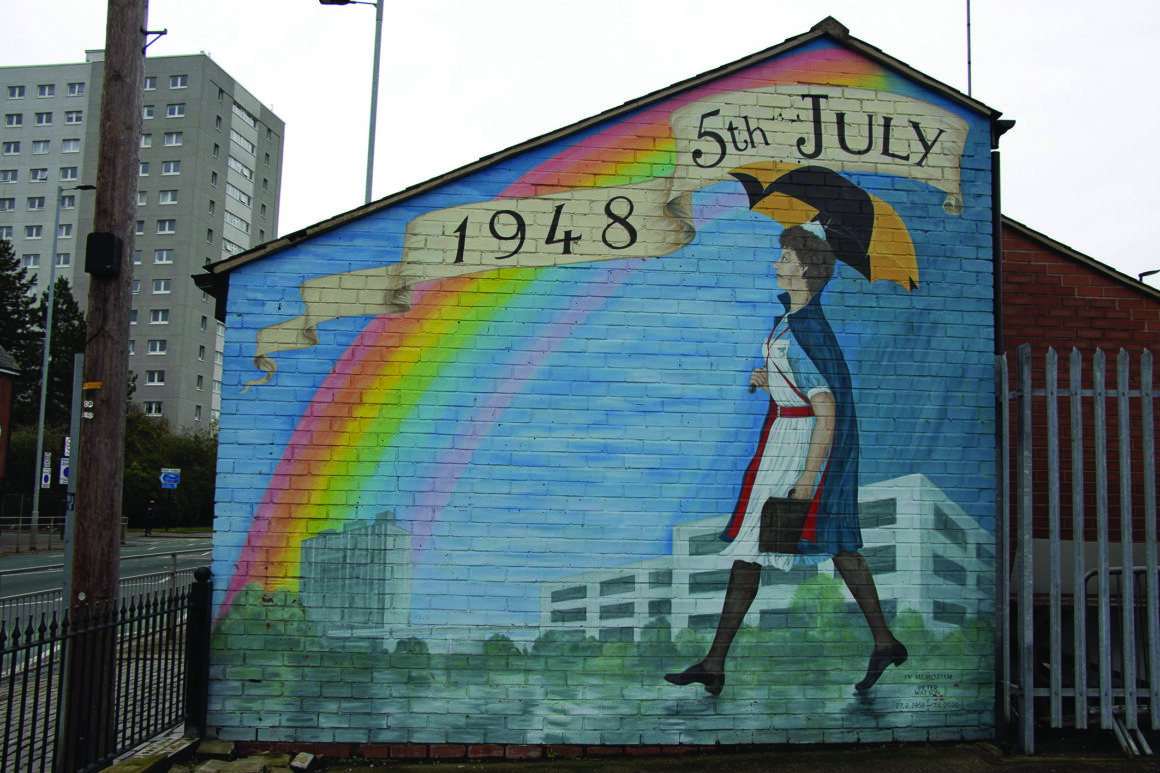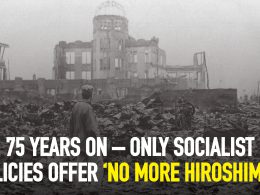The following article was first published in issue #18 of Socialist Alternative, the theoretical magazine of Socialist Party.
The decimation of the NHS by successive government in Britain has been a major political issue in recent years. The NHS is not what it once was, but its founding 75 years ago was a major victory for the working class, and the result of years of determined struggle — which needs to be returned to if the NHS is to be saved and the damage undone. Eva Martin looks back at the momentous event.
Anyone who has used the NHS for health care will know how desperate the situation has gotten and how deep a crisis the NHS is in. The empty rhetoric of the Tories, that they are ‘the party of the NHS’ couldn’t be more insulting. Yet the fact that they feel pressured to declare it in every election manifesto, while implementing a swathe of ruthless budget cuts, indicates the degree to which the NHS is valued by voters.
In the context of both the NHS and its workers being at crisis point – the argument that ‘I cannot strike because of my patients’ has been flipped on its head, and now workers are having to take strike action to defend the NHS and their patients. This is vital. If we are to save the NHS from collapsing entirely, but also restore it to its original functioning and vision – a free, universal health service run in the interests of all health care needs, including mental, dental, sexual and reproductive health care; then it is imperative that we learn the lessons from the historic struggle that brought about the NHS in the first place.
For it would be wholly inaccurate to paint the path to establishing the NHS as smooth. Behind the NHS lies a long and mass struggle led by the organised workers’ movement, armed with a socialist vision of free health care being a right.
Healthcare before the NHS
The NHS was established in 1948. Before that, access to health care was largely dependent on one’s ability to pay for treatment. Primary care took precedence and was provided by an army of general practitioners (GPs) who often performed surgery and other treatments at paying clients’ homes. GPs were free to operate where they wished and charge however much they wanted, meaning access only for the wealthier classes. Where health care was available for free or cheaply, it was delivered through centres derived from the Victorian workhouse infirmaries, which for a growing proportion of Britain’s workers and poor became the norm for hospital care, or a voluntary sector run on a charitable basis mostly by religious institutions. The role of religious institutions was particularly prevalent in Northern Ireland.
To say these alternative options for medical treatment were inadequate would be an understatement. For example, when the medical journal The Lancet established a commission to examine the conditions of workhouse infirmaries in 1865, it concluded the facilities to be: “a disgrace to our civilisation… a sin by their construction, by their want of nursing, by their comfortless fittings, by the supremacy which is accorded to questions of expense, by the imperfect provision made for skilled medical attendance on the sick, by the immense labour imposed on the medical attendants, and the wretched pittances to which they are ground down.”1 Conditions in workhouse infirmaries were so poor and unhygienic that explosions in infectious diseases were commonplace.
Workhouses were established as a by-product of the Poor Law (1834), which classified poverty as a moral failing, therefore a punishable offence through hard labour. The workhouses remained places of terror for workers, the elderly, the poor, and the disabled well into the 20th century, despite theoretically coming to an end with the transfer of the Poor Law to local authorities in 1929. In reality they continued to exist under local authority control in the form of ‘Public Assistance Institutions’ until the final abolition of the Poor Law in 1948. The alternative option of voluntary hospitals, often run by religious institutions, brought with them equally traumatic experiences for working-class people, particularly women, children, and LGBTQ+ people, as harsh methods of ‘discipline’ and punishment would be exercised – ranging from hard labour, to solitary confinement, to corporal punishment. This was again particularly prevalent in Northern Ireland where religious institutions were significantly stronger in society and able to exercise greater control than in any other part of the UK
Working-class women who fell pregnant outside of marriage were often sent to religious institutions to deliver their babies, and were subjected to verbal and psychological abuse. Similarly for the LGBTQ community. For example, the Mater Hospital was established as a voluntary hospital in 1883 in North Belfast by the Sisters of Mercy. The use of psychological abuse and electroshock therapy as a means of ‘conversion therapy’ was employed in the Mater right up to 1973, as the hospital existed outside the NHS until then due to the Catholic Church being unwilling to relinquish control over the facilities and the state being unwilling to challenge its authority.
Labour movement takes up the fight
The horrific conditions in the infirmaries led to public outrage and campaigns for reform, the first of which was won in 1911 when the Liberal government introduced the National Insurance Act. Though a step forward, the underlying logic of these measures was not to improve the health of workers, but to boost productivity and output by reducing sick days. The scheme was wholly inadequate and failed to tackle the issue of inaccessible health care in any meaningful way, as it was financially tied to the workplace, provided only for GP care, and introduced insufficient sick pay. Keir Hardie, leader of the Labour Party at the time, declared the scheme to be a “porous plaster to cover the disease that poverty causes.”2 Resistance to centralisation from the top and lack of investment in vaccines meant thousands of children died every year from infectious diseases including pneumonia, diphtheria, and polio. Surveys showed that up to 80% of children in the mining areas of county Durham and the poorest boroughs of London had signs of rickets.
At the turn of the 20th century, an outbreak of Tuberculosis swept across Europe, killing over 6 million people in Britain alone. Poor, working-class people were most vulnerable to infection due to overcrowded living conditions. Northern Ireland was particularly impacted by the outbreak as it had some of the highest rates of poverty per capita in Europe.
The misery suffered by working-class communities provoked deep anger. The growing working-class movement in the years preceding the First World War made fighting for public healthcare one of its priorities. This struggle went beyond local areas, with both the Labour Party and Trades Union Congress (TUC) adopting policies calling for a national health service decades before its arrival. Similarly, organisations such as the Workers’ Birth Control Group established by women in mining areas came out with the slogan: “It’s four times as dangerous to bear a child as to work down a mine.”3
The growing strength of the labour movement also began to be reflected in electoral politics, with Labour’s vote increasing from 300,000 in 1910 to 2.2 million by the 1918 general election. The impact of the First World War had further underlined the desperate need for progressive reforms including fair pay, better housing, and healthcare. A series of significant strikes followed soon after in 1919–20, involving more than 2 million workers across various industries, prompting great fears about the threat of “Bolshevism” from the ruling class and the Conservative-Liberal coalition government.
The Department of Health was established in 1920 as a result of this pressure and produced what became known as the ‘Dawson Report’. Though a far cry from the idea of an NHS and defeated in parliament, the report represented a gain for the working class and a shift in government thinking on public health as it concluded that Britain’s hospitals should be brought together under a national system. It would be another six years before the Royal Commission on National Health, off the back of a nine-day general strike of 1.7 million workers, would advocate for public funds to partially cover health-care costs.
In 1929, the minority Labour government introduced the ‘Local government Act’ in an attempt to expand state and charitable provision, but the overall British healthcare system remained very much dominated by conservative ethos and was divided strictly by class. The 1930s brought more of the same, with an expansion of public health programs but little by way of structural changes in provision, and the great depression exacerbating poor conditions and already stretched charitable services.
The World War and its ramifications
It wasn’t until the Second World War that a major shift occurred in the struggle for universal healthcare. The sharp increase in demand for emergency medical services dramatically exposed the deficiencies of the country’s divided and unequal healthcare system. As the war went on, the workers’ movement faced a huge setback as millions were conscripted and killed. The ‘Battle of Britain’ in 1940 left infrastructure in ruin with unprecedented aerial bombing of British cities, and society in general was devastated. As historian Charles Webster put it, “in a few short years the Luftwaffe had forced through a rationalisation in British health care that the government had failed to implement since 1920”.4
During the war a “national unity” capitalist government was established; a coalition government between the Tories and Labour. While this was posed as a necessary alliance, with the war effort requiring an ‘abandoning of rivalry between capital and labour for a common cause’, as The Times put it, in reality this alliance represented a capitulation of Labour to the interests of capitalism. This included implementing ‘Order 1305’, which banned strike action. The interests of working-class people were made subservient to the interests of British capitalism. As a result, workers’ struggle stagnated.
The living conditions and rights of workers were heavily eroded in the name of the war effort, but as it began to become clear that the end of the war was in sight come 1943, resentment grew towards the abysmal conditions in which working-class people were forced to live, and so too did working-class consciousness. What was the point of millions dead, displaced, maimed, and society in ruin if victory in the war meant sustained misery and hardship for the majority of the population? More fundamentally, workers began to question the logic of the free market and the limitations of capitalism – why was a decent quality of life for all supposedly impossible to achieve despite the fact that the wealth and infrastructure clearly existed?
Furthermore, not only did the increased demand on medical services during the war quickly expose the chronic inadequacies of the British healthcare system, it forced the government to attempt to introduce emergency national control over hospitals for the first time, with the central government dictating the functioning, and increasing funding for all services throughout the war. The fact that 90% of the economy had been nationalised under state direction during the war, bringing the majority of the population into employment and increasing productive output (even if it was geared towards the war effort and not social needs), was not lost on people. If it was possible to plan the economy for the war effort – then it was possible for everything else. The consensus among the working class was clear; there could be no return to the pre-war status quo.
Elite opposition
The opposition Labour Party pushed for a broad-based review of Britain’s social infrastructure and services. The result was the ‘Beveridge Report’, authored by William Beveridge, published in November 1942. While the proposals in the Beveridge Report were again a far cry from a national health service, it was nonetheless met with widespread approval among the British public and became synonymous with the idea of a welfare state. Despite the overwhelming support for the Report and the idea of a public healthcare system, Churchill, a section of the Tory party, and his most loyal supporters remained vehemently opposed to the idea – comparing the concept of a national health service to Hitler’s ‘National Socialism.’
Other sections of society were also opposed to the idea of establishing a free national healthcare system, including GPs who were reluctant to surrender the powerful and affluent position they held in society thanks to privatised healthcare. GPs were so opposed to the establishment of the NHS that bitter industrial battles in fact played out across the UK during 1943/44, with GP’s going on strike. Due to their powerful position, the government was forced to grant concessions on a number of issues, including the guarantee that GP surgeries remain private businesses available to be bought and sold.
In Northern Ireland, the ruling-class on either side of the sectarian divide also proved reluctant to accept the idea of a national healthcare system. As previously mentioned, living conditions in the North for both Protestant and Catholic workers were horrific, with higher rates of infectious diseases, malnutrition, and poverty per capita than anywhere else in the UK. Free comprehensive healthcare was something that all workers had a vested interest in gaining and established a basis for working-class unity to bring about its creation. This posed a major threat to official Unionism and the status quo of sectarian divide and rule on which its rule was maintained, as well as the Catholic Church’s power over the Catholic population in the North, as the NHS would provide an alternative to their institutions, including their hospitals.
Unstoppable momentum
Some within the political establishment did, however, see the truth of the matter: the popularity of the proposal for a NHS had grown too strong and the demands for its establishment could not be ignored. If the ruling class was to avoid outright civil unrest and the potential for further workers’ struggle, it needed to act. As Tory MP Quintin Hogg stated in the 1943 parliamentary debate on the Beveridge Report: “if you do not give the people social reform, they are going to give you social revolution.”5
It was off the back of this growing momentum and radicalisation that came the general election of 1945, with which Labour was voted into power in a landslide victory. Winston Churchill, the supposed hero of the battle against Hitler, was unceremoniously dumped out of office with his Conservative Party. It was a historic moment for working-class politics, and it reflected the strength of sentiment for change that existed among the working class.
Welsh socialist Nye Bevan, who has been credited with having greater influence on the formation of the NHS than any other politician, was appointed to the position of Minister for Health in Clement Atlee’s cabinet. Bevan understood medical care to be a right and was determined to imbue the construction of the NHS with his socialist principles. He set in motion the necessary policies and mechanisms that paved the path to the NHS’s creation three years later. The path was by no means straightforward of course, as each proposal and attempt to advance was met with resistance by the most reactionary sections of the ruling class.
In the three-year period building up to the NHS, the British Medical Association would prove to be the business class’s biggest bulwark against it. Nevertheless, Bevan and the most militant socialist left in the Labour Party and broader labour movement persevered in their fight for a NHS that delivered high-quality, free medical treatment upon request for any medical ailment or concern. On 5 July 1948, the NHS was founded.
Conclusion
The establishment of the NHS was indisputably one of the great worker victories of the 20th century. The NHS provided universal, equitable, comprehensive, high-quality health care free at the point of delivery, funded by central taxation not insurance. While the role played by Bevan was undoubtedly important in the founding of the NHS, its creation was a mark of the strength of the labour movement and the socialist left’s influence inside and outside parliament in the wake of the 1945 election.
Atlee’s Labour government, under the pressure from the working-class movement, implemented incredibly far-reaching reforms. In the decade after the establishment of the NHS, many other states sought to introduce public health care – but none provided it so widely, so effectively, and as a right to so many.
Unfortunately, successive Labour and Tory governments have introduced privatisation a piece at a time, combined with underfunding the service, decimating the NHS bit by bit. The introduction of Private Finance Initiatives (PFI), Community Care Acts and Accountable Care Organisations (ACOs), based on the US private insurance industry-devised model, have run the NHS into the ground. We are paying the price for the mistakes of the 1945 Labour government, which went so far in introducing social reforms that vastly improved the lives of working-class people, but which left capitalism intact – and all those reforms open to attack, which they have been under ever since.
The contradictions of a free public health service providing universal medical treatment under the system of capitalism, a system which necessitates the constant commodification of resources and services in the pursuit of profit, has inevitably grown sharper. In the same way the NHS was won – through determined working-class struggle, we must now defend it.
Notes
1. The Lancet Report, 1865, volume 86, no. 2189, p.177. www.thelancet.com
2. Emrys Hughes, Keir Hardie (1956) p. 200. Accessed at: https://spartacus-educational.com/Linsurance1911.htm
3. Russell, D., 1983. Book Review: Fair Sex: Family Size and Structure 1900–1939
4. Ronan Burtenshaw, 5 Jul 2019, ‘How the NHS was won’, www.tribunemag.co.uk
5. Lewis, G., 2002. Quintin Mcgarel Hogg, Lord Hailsham of St Marylebone. 9 October 1907–12 October 2001. Biographical Memoirs of Fellows of the Royal Society, (48), pp.221-231












